Thermal Performances Investigation of Anti-Gravity Heat Pipe with Tapering Phase-Change Chamber
Abstract
1. Introduction
2. Materials and Methods
2.1. Fabrication of Heat Pipe
2.2. Experimental Step
2.3. Data acquisition and Uncertainty Analysis
3. Results and Discussions
3.1. Wick Morphology and Structure Analysis
3.2. Thermal Resistance
3.3. Start-Up Characteristic
3.4. Maximum Temperature
4. Conclusions
Author Contributions
Funding
Conflicts of Interest
Nomenclature
| a | Major axis of the copper powder, μm |
| b | Minor axis of the copper powder, μm |
| d1, d2 | Diameters of vapor chamber at different locations, m |
| de | Equivalent diameter of copper powder, μm |
| e | Ratio of the major axis to minor axis of the copper powder |
| Exi | Maximum measurement error of the independent variable xi |
| E(y) | Measurement error of single-sample test, % |
| P | Heating power, W |
| Re | Thermal resistance, °C/W |
| Tc | Temperature of condenser, °C |
| Te | Temperature of evaporator, °C |
| V1,V2 | Velocities of the vapor before and after chamber changing, m/s |
| y | Given function of the independent variable xi |
References
- Xiang, J.; Zheng, H.; Wang, Y.; Zhang, C.; Zhou, C.; Chen, C. Numerical Simulation, Machining and Testing of a Phase Change Heat Sink for High Power LEDs. Materials 2019, 12, 2193. [Google Scholar] [CrossRef] [PubMed]
- Xiang, J.; Zhang, C.; Zhou, C.; Huang, J.; Liu, G.; Zhao, H. An integrated radial heat sink with thermosyphon for high-power LEDs applications. Heat Mass Transf. 2019, 55, 2455–2467. [Google Scholar] [CrossRef]
- Wang, G.; Quan, Z.; Zhao, Y.; Wang, H. Performance of a flat-plate micro heat pipe at different filling ratios and working fluids. Appl. Therm. Eng. 2019, 146, 459–468. [Google Scholar] [CrossRef]
- Ömür, C.; Uygur, A.B.; Horuz, İ.; Işık, H.G.; Ayan, S.; Konar, M. Incorporation of manufacturing constraints into an algorithm for the determination of maximum heat transport capacity of extruded axially grooved heat pipes. Int. J. Therm. Sci. 2018, 123, 181–190. [Google Scholar] [CrossRef]
- Kim, S.J.; Seo, J.K.; Do, K.H. Analytical and experimental investigation on the operational characteristics and the thermal optimization of a miniature heat pipe with a grooved wick structure. Int. J. Heat Mass Transf. 2003, 46, 2051–2063. [Google Scholar] [CrossRef]
- Jiang, L.; Tang, Y.; Pan, M. Effects of bending on heat transfer performance of axial micro-grooved heat pipe. J. Cent. South Univ. Technol. 2011, 18, 580–586. [Google Scholar] [CrossRef]
- Lee, S.; Lee, J.; Hwang, H.; Yeo, T.; Lee, H.; Choi, W. Layer-by-layer assembled carbon nanotube-polyethyleneimine coatings inside copper-sintered heat pipes for enhanced thermal performance. Carbon 2018, 140, 521–532. [Google Scholar] [CrossRef]
- Li, Y.; He, J.; He, H.; Yan, Y.; Zeng, Z.; Li, B. Investigation of ultra-thin flattened heat pipes with sintered wick structure. Appl. Therm. Eng. 2015, 86, 106–118. [Google Scholar] [CrossRef]
- Li, H.; Wang, X.; Liu, Z.; Tang, Y.; Yuan, W.; Zhou, R.; Li, Y. Experimental investigation on the sintered wick of the anti-gravity loop-shaped heat pipe. Exp. Thermal Fluid Sci. 2015, 68, 689–696. [Google Scholar] [CrossRef]
- Zhou, W.; Xie, P.; Li, Y.; Yan, Y.; Li, B. Thermal performance of ultra-thin flattened heat pipes. Appl. Therm. Eng. 2017, 117, 773–781. [Google Scholar]
- Li, Y.; Zhou, W.; He, J.; Yan, Y.; Li, B.; Zeng, Z. Thermal performance of ultra-thin flattened heat pipes with composite wick structure. Appl. Therm. Eng. 2016, 102, 487–499. [Google Scholar] [CrossRef]
- Tang, Y.; Zhou, R.; Lu, L.; Xie, Z. Anti-Gravity Loop-shaped heat pipe with graded pore-size wick. Appl. Therm. Eng. 2012, 36, 78–86. [Google Scholar] [CrossRef]
- Jahan, S.A.; Ali, M.; Islam, M.Q. Effect of Inclination Angles on Heat Transfer Characteristics of a Closed Loop Pulsating Heat Pipe (CLPHP). Procedia Eng. 2013, 56, 82–87. [Google Scholar] [CrossRef]
- Wang, C.; Liu, Z.; Zhang, G.; Zhang, M. Experimental investigations of flat plate heat pipes with interlaced narrow grooves or channels as capillary structure. Exp. Therm. Fluid Sci. 2013, 48, 222–229. [Google Scholar] [CrossRef]
- Deng, W.; Xie, Z.; Tang, Y.; Zhou, R. Experimental investigation on anti-gravity loop heat pipe based on bubbling mode. Exp. Therm. Fluid Sci. 2012, 41, 4–11. [Google Scholar] [CrossRef]
- Hanlon, M.A.; Ma, H.B. Evaporation Heat Transfer in Sintered Porous Media. J. Heat Transf. 2003, 125, 644–652. [Google Scholar] [CrossRef]
- Lips, S.; Lefèvre, F. A general analytical model for the design of conventional heat pipes. Int. J. Heat Mass Transf. 2014, 72, 288–298. [Google Scholar] [CrossRef]
- Elnaggar, M.H.A.; Abdullah, M.Z.; Abdul Mujeebu, M. Characterization of working fluid in vertically mounted finned U-shape twin heat pipe for electronic cooling. Energy Convers. Manag. 2012, 62, 31–39. [Google Scholar] [CrossRef]
- Tang, H.; Lian, L.; Zhang, J.; Liu, Y. Heat transfer performance of cylindrical heat pipes with axially graded wick at anti-gravity orientations. Appl. Therm. Eng. 2019, 163, 114413. [Google Scholar] [CrossRef]
- Moffat, R.J. Describing the Uncertainties in Experimental Results. Exp. Therm. Fluid Sci. 1988, 1, 3–17. [Google Scholar] [CrossRef]
- Lee, J.; Kim, S.J. Effect of channel geometry on the operating limit of micro pulsating heat pipes. Int. J. Heat Mass Transf. 2017, 107, 204–212. [Google Scholar] [CrossRef]


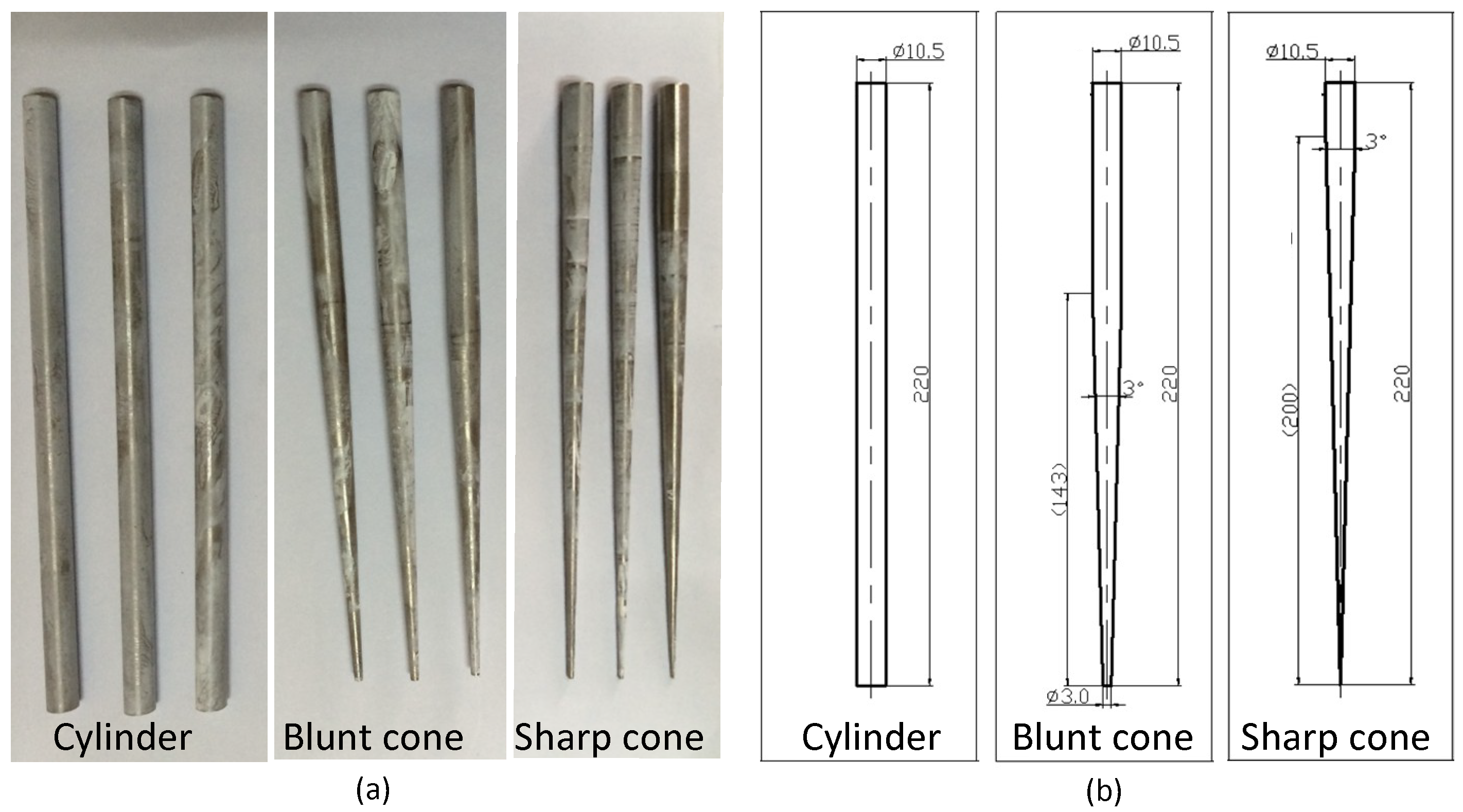
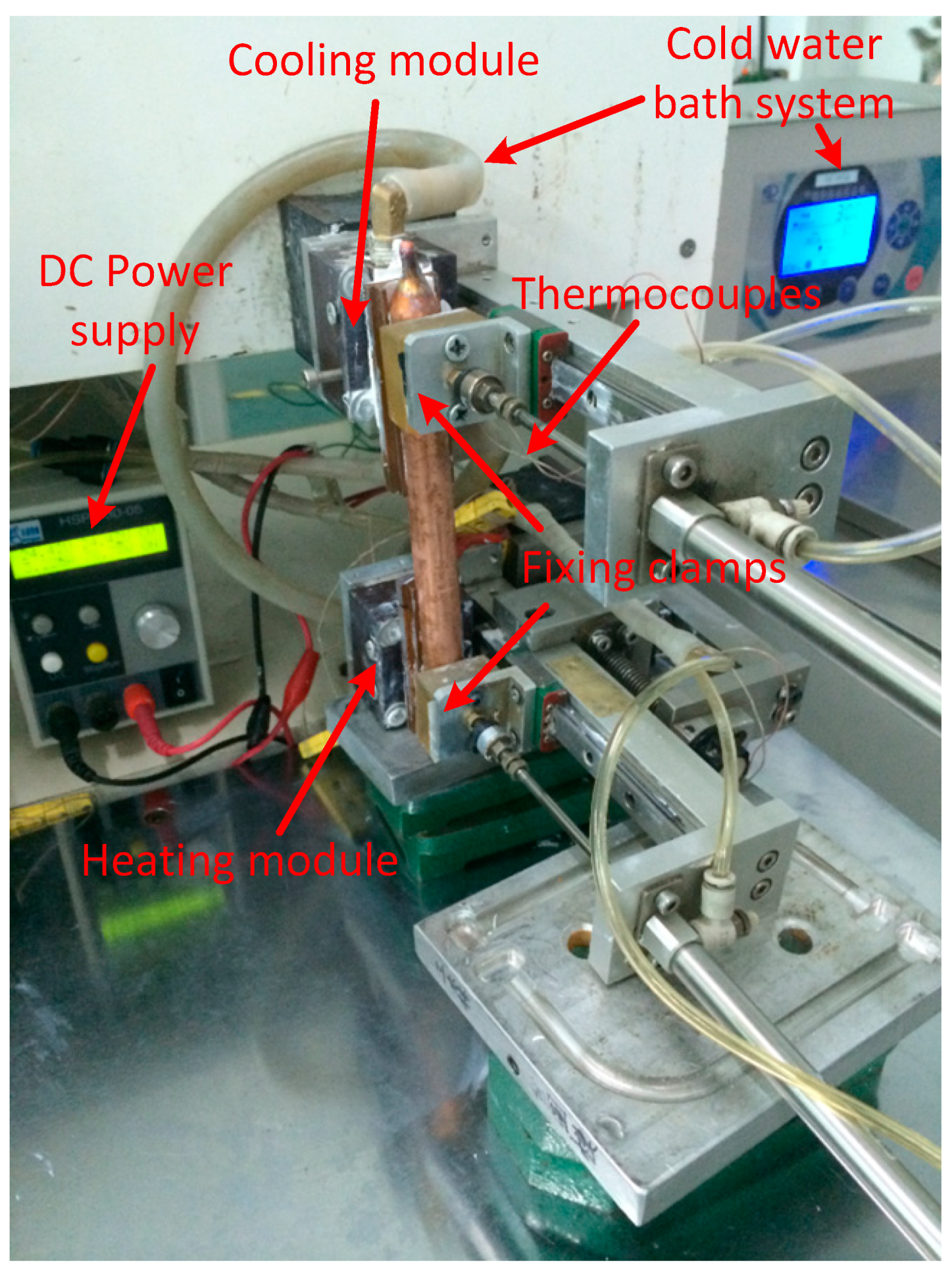
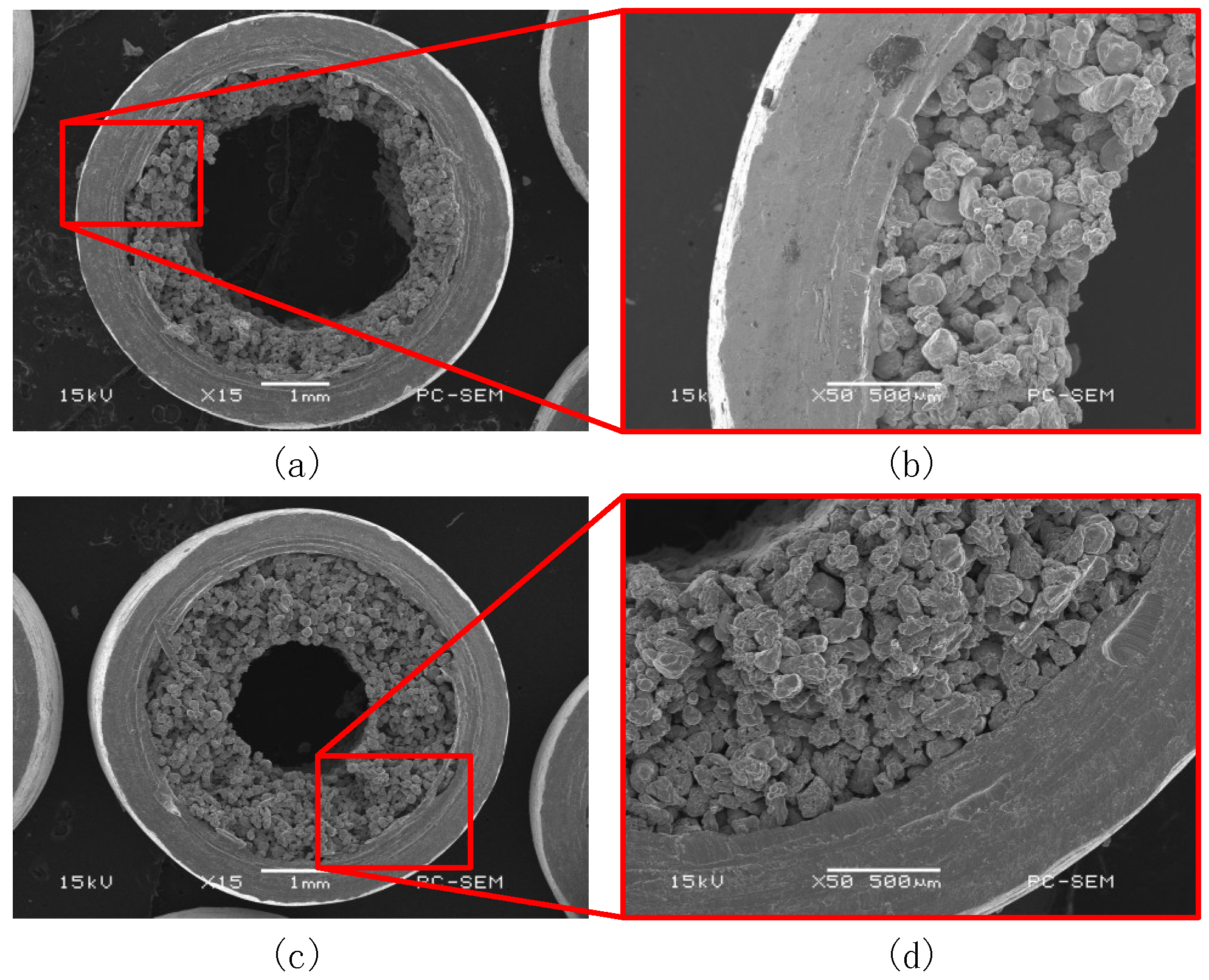

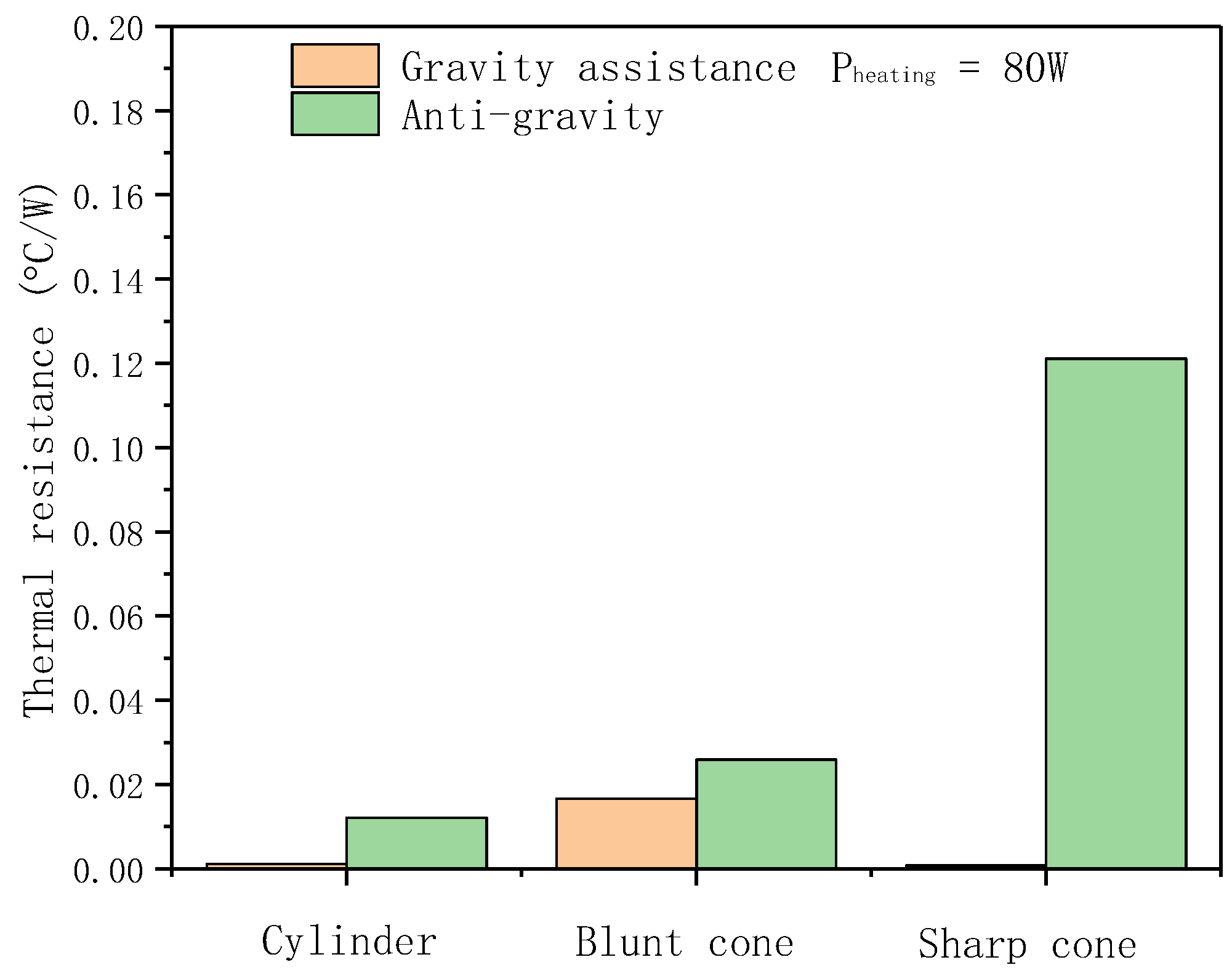

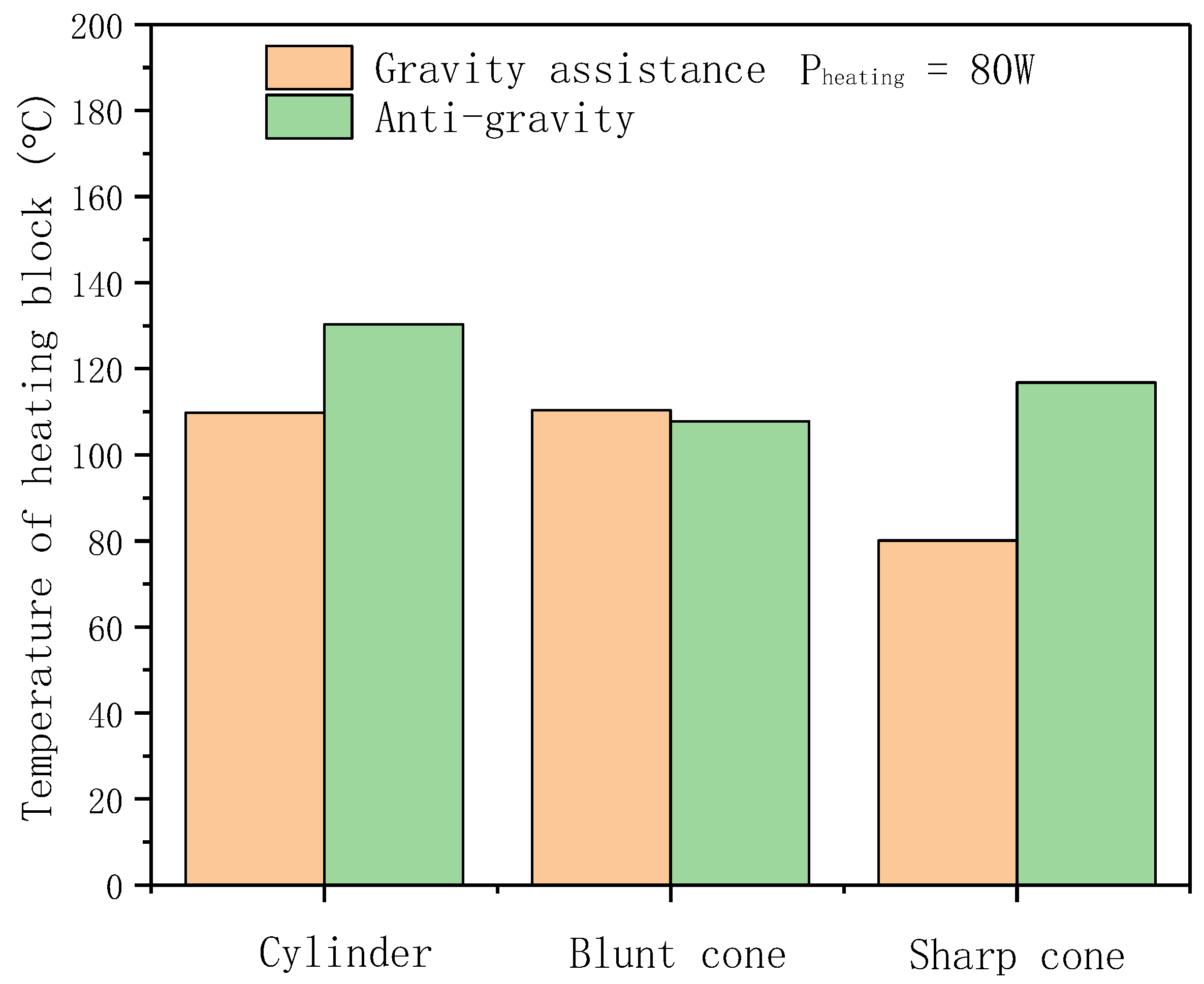

© 2020 by the authors. Licensee MDPI, Basel, Switzerland. This article is an open access article distributed under the terms and conditions of the Creative Commons Attribution (CC BY) license (http://creativecommons.org/licenses/by/4.0/).
Share and Cite
Xiang, J.; Chen, X.-b.; Huang, J.; Zhang, C.; Zhou, C.; Zheng, H. Thermal Performances Investigation of Anti-Gravity Heat Pipe with Tapering Phase-Change Chamber. Energies 2020, 13, 5036. https://doi.org/10.3390/en13195036
Xiang J, Chen X-b, Huang J, Zhang C, Zhou C, Zheng H. Thermal Performances Investigation of Anti-Gravity Heat Pipe with Tapering Phase-Change Chamber. Energies. 2020; 13(19):5036. https://doi.org/10.3390/en13195036
Chicago/Turabian StyleXiang, Jianhua, Xi-bo Chen, Jiale Huang, Chunliang Zhang, Chao Zhou, and Haoxing Zheng. 2020. "Thermal Performances Investigation of Anti-Gravity Heat Pipe with Tapering Phase-Change Chamber" Energies 13, no. 19: 5036. https://doi.org/10.3390/en13195036
APA StyleXiang, J., Chen, X.-b., Huang, J., Zhang, C., Zhou, C., & Zheng, H. (2020). Thermal Performances Investigation of Anti-Gravity Heat Pipe with Tapering Phase-Change Chamber. Energies, 13(19), 5036. https://doi.org/10.3390/en13195036





